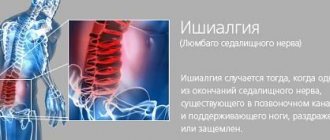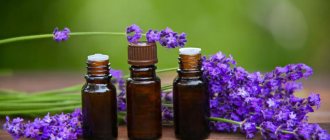- April 3, 2019
- Neurology
- Natalie M
Sciatica or lumbosacral radiculitis is a very complex disease, which is an inflammation of the roots of the lumbosacral spine in general and the largest sciatic nerve in the human body in particular.
The sciatic nerve begins in the lumbar spine and, passing through the gluteal region, descends to the lower limb. It is precisely because of the vastness of the “territories” that this nerve occupies that patients with sciatica experience severe pain.
Types of disease
Based on the degree of damage, sciatica is divided into several types:
- upper - characterized by damage to the cord and nerve roots;
- medium (called plexitis) – damage to the sciatic nerve occurs at the level of the nerve plexus;
- lower (or neuritis of the sciatic nerve) - extensive damage to the trunk and branches of the sciatic nerve.
Sciatica can occur for various reasons, among which the most “popular” are spinal injuries, hypothermia, awkward and improper lifting of weights, and also, in some cases, metabolic disorders and diabetes mellitus.
Along with these reasons, the disease can occur due to constant uneven loads on the spine, as well as incorrect posture. In addition, one of the main causes of such a disease as lumbosacral radiculitis are intervertebral hernias in the lumbar spine, which put pressure on the sciatic nerve and cause neuralgia. Due to changes in the configuration of the pelvis, sciatica often occurs in pregnant women.
Classification
Sciatica is also classified according to the nature of the cause of the disease. Thus, lumbosacral radiculitis is divided into:
- Primary – caused by intoxication of the body (due to poisoning with arsenic, carbon monoxide, etc.), gout or infection.
- Secondary - manifests itself due to problems with the tissues that surround the sciatic nerve. Secondary sciatica also includes diseases resulting from degenerative changes in the intervertebral discs of the lumbar and lumbosacral spine (osteochondrosis, disc herniation, etc.).
Symptoms
Symptoms of sciatica usually include severe pain in the lower back, lower buttocks, and hamstrings. In addition, with sciatica, patients may experience burning, tingling and numbness in the lumbosacral spine, which is also caused by irritation of the sciatic nerve.
With a long and serious course of the disease, patients experience difficulty walking, bending and any other physical activity. The nature of pain can be very diverse - from dull constant pain to periodic sharp attacks.
Clinical manifestations and diagnosis
Before treating inflammation of the sciatic nerve at home, you need to make sure that it is sciatica and not some other disease. Independent differential diagnosis is in principle impossible. Due to the subjective assessment of his condition, the patient cannot exclude various serious pathologies both at the level of the spinal column and at the level of large joints of the lower extremities.
Before treating inflammation of the sciatic nerve at home, we recommend that you find out the symptoms of this process:
- sharp burning pain in the buttock area, spreading along the back of the thigh to the knee and heel;
- any movement of the leg on the affected side leads to a sharp increase in the intensity of pain;
- muscle weakness appears, since several muscle branches, responsible for the innervation of the muscles, depart from it along the sciatic nerve;
- areas of numbness appear in the lumbar region, sacrum, buttocks, thighs or lower legs;
- pain can be localized in the lumbar and heel areas;
- the trophism of soft tissues is gradually disrupted (the intensity of blood flow decreases, the skin becomes pale, cold and dry to the touch);
- signs of dystrophy and atrophy of muscle tissue appear.
If inflammation of the sciatic nerve is not treated correctly, the hip and knee joints will gradually begin to deteriorate, and the lower limb will begin to lose its volume and mobility. Stable contractures will form, and trophic ulcers may begin to appear on the tissues of the lower leg.
Next, we will look at how the sciatic nerve is treated at home using various techniques and medications. You will learn about their effectiveness and possible side effects.
Features of therapy
Treatment of sciatica is a complex measure that includes reducing pain, as well as treating the cause of this disease.
Traditional therapy for sciatica begins with the prescription of steroidal and non-steroidal anti-inflammatory drugs, the action of which is aimed at reducing the degree of pain and reducing the development of inflammatory processes.
This therapy is very serious, has a number of contraindications and should be prescribed directly by a doctor. In addition, at the slightest sign of lumbosacral radiculitis, it is necessary to contact an appropriate specialist, since detection and treatment of inflammation of the sciatic nerve in the early stages is much more gentle and can be carried out even with the help of manual therapy.
In addition to traditional drug treatment for sciatica, it is advisable to engage in special health-improving exercises, which help to relax the lower back and relieve tension from the inflamed areas of the spine.
Such gymnastics, if possible, should be carried out under the supervision of a doctor, since sudden movements and incorrect body position, which the patient can assume while performing the exercises on their own, are extremely contraindicated in this disease.
Along with medications and exercises, traditional healers suggest treating sciatica with natural medicines - infusions, rubs and ointments based on herbs and roots. Such therapy can be carried out, but only in combination with traditional therapy and always under the supervision of a doctor.
We place banks in accordance with the rules
Is it possible to use such a folk remedy for sciatica as cupping? When installing the can, it sticks to the skin, forming an even red circle. The flow of lymph and blood rushes into this place, and this contributes to the development of the following effects:
- organs and tissues begin to actively receive nutrients;
- the body's resistance to infections increases;
- the inflammatory process goes away much faster;
- growths on the spine begin to gradually dissolve;
- muscle tone and elasticity increase.
Therefore, it is possible and necessary to use cupping for nerve inflammation, you just need to know how to do it correctly. Cupping treatment is very effective. There are several types of jars: regular glass, vacuum, silicone and rubber. You can buy any at the pharmacy. Glass medicine jars can be replaced with mayonnaise jars or after baby food.
Rules for placing glass jars:
- Apply Vaseline to clean skin in the desired area.
- Cotton wool is wrapped around a long stick.
- Dip it in alcohol and set it on fire.
- Using this method, the jar is heated from the inside for 3-5 seconds and attached to the skin. The container, as a rule, suctions well.
- The patient is covered with a warm blanket from above for the warm-up period and then after the procedure.
Vacuum cans are much more convenient and safer. They do not need to be heated with an open fire. When attaching the can, a vacuum is created using a balloon.
It is enough to squeeze a soft silicone or rubber jar on the sides, press it to the skin and release the sides. To achieve the maximum effect from cupping treatment, you need to perform massage movements. This procedure is easy to carry out independently. This massage is performed for about 15 minutes, after which you need to lie down under the blanket for another 20 minutes to consolidate the therapeutic effect.
Cupping massage can be dynamic or static. Dynamic massage consists of moving one fixed can over the sore area in a variety of ways, without lifting it from the skin. Static massage is the fixation of cups at certain points, which helps relieve the condition of a pinched sciatic nerve.
Treatment with traditional methods of the sciatic nerve
As noted above, traditional drugs prescribed for the treatment of sciatica have many side effects and contraindications. Therefore, one should not neglect the methods of alternative medicine, which has an extensive arsenal of very effective recipes.
The main part of these recipes for the treatment of the sciatic nerve with folk remedies is intended for external use - these are various rubbings, baths, ointments and compress substances. But there are also folk remedies for oral use. It should be recalled that treating inflammation of the sciatic nerve with folk remedies without consulting a doctor can lead to unpleasant consequences. Problems with the gastrointestinal tract, liver and kidneys may occur. So, let's look at the features of treating the sciatic nerve at home.
Treatment of illness with traditional medicine recipes
In traditional medicine, drug treatment is used in the first stages of this disease. Its goal is to eliminate the main symptoms, including pain and inflammation.
Treatment with folk remedies for inflammation of the sciatic nerve can also be effective in the initial stages of the disease. Despite the fact that many experts believe that they cannot completely cure sciatica, there are a huge number of examples where folk recipes helped get rid of the main symptoms of inflammation.
Oral preparations
Basically, for oral administration you need to prepare various decoctions and infusions. How to treat a sciatic nerve at home? For this you can use the following compositions:
- Pour boiling water (500 ml) over two teaspoons of horse chestnut seeds, leave in a water bath for a quarter of an hour, strain, then cool. Drink half a glass before meals.
- Pour boiling water (500 ml) over two tablespoons of dried calendula flowers, leave in a tightly closed cup for at least two hours, then strain thoroughly. Drink 100 ml before meals several times a day.
Treatment of pinched nerves with folk remedies
Content:
Treatment of pinched nerves with ointments
Traditional medicine knows various recipes for healing ointments and oils that will help cope with a problem that bothers many - pinched nerves.
Combine juniper needles with bay leaves in a ratio of 1 part to 6 and thoroughly grind to a powder, then mix this mass with 12 parts of melted butter. If a nerve is pinched, this folk remedy will perfectly help relieve pain and relax tense muscles.
An effective remedy is also an ointment made from a tablespoon of powdered hop cones and a tablespoon of butter or lard. The components are stirred and the resulting mixture is rubbed into the sore spot.
If you mix a couple of tablespoons of bleached butter with a tablespoon of ammonia, lubricate the sore spot with this and wrap it in a warm scarf, the pain will become much less intense.
Ointment made from pork fat and a steep decoction of lilac buds are also suitable for rubbing. The medicinal properties of garlic oil are also known, a tablespoon of which must be diluted with half a liter of vodka and lubricated on the sore spot.
To cure a pinched nerve, melt the wax, mix it with wax and olive oil, soak a linen cloth with this mixture and place it on your neck or lower back, securing it with a plaster on top.
Treatment of pinched nerves with baths
A good folk remedy for treating pinched nerves are baths with various medicinal decoctions and infusions. It is recommended to take a warm bath (35–37 °C) with a decoction of calamus roots (250 g of raw material is boiled in three liters of water). You can also boil calamus with creeping thyme (its stems and leaves): the components are taken equally and prepared similarly to the first method.
Oak or spruce bark (1 kg) is boiled in five liters of water for half an hour, then strained and added to the bath. The temperature of the water in the bath should not exceed 37 °C.
It is also useful to take a bath with cereal flowers. Collect a kilogram of flowers, add cold water (5 liters) and cook for 30 minutes, then strain through cheesecloth and pour into the bath. The product is suitable for both local (lumbar) and general baths or compresses.
The healing properties of horse chestnut are also known to folk medicine. The young fruits of this tree (one and a half kilograms) must be boiled for half an hour in five liters of water, then add the strained decoction to the bath. Knotweed, chamomile or sage are similarly used to treat pinched nerves. 250–300 g of any of these plants are poured with boiling water (5 l) and left for a couple of hours, after which they are strained and poured into the bath.
Suitable for medicinal baths is the herbal mixture, which includes black elderberry, oregano herb, burdock, nettle, tansy, juniper, black currant leaves, wheatgrass, pine buds, horsetail, hops, violet and thyme. All components should be mixed in equal quantities, add 8 tablespoons of the mixture to boiling water (2 liters) and cook for ten minutes. Then the broth should be cooled to 37 °C, strained and added to the bath.
Treatment of pinched nerves with infusions
A variety of medicinal infusions in the treatment of pinched nerves are used for both internal and external use.
As a pain reliever, it is recommended to use a tincture prepared from mullein flowers (bear ears). Flowers (50 g) are poured into a liter of vodka and left until ready for a couple of weeks, after which they are rubbed into sore spots. Lilac tincture is prepared in a similar way: a glass of lilac flowers is infused with vodka (500 ml) for several days.
An infusion of wormwood citvar is also a good external remedy for pain relief. Infuse a tablespoon of wormwood inflorescences in boiling water (350 ml) for a couple of hours, then rub the neck, spine or lower back.
An infusion of lingonberry leaves is perfect for internal use: brew 1 teaspoon of plant leaves in boiling water (1.5 cups) for an hour, then drink half a glass three times a day.
It is also useful to drink an infusion of elderberry, the dry inflorescences or berries of which in the amount of one tablespoon are brewed in a glass of boiling water. In half an hour, the infusion will be ready; take it, after cooling, half a glass twice a day before meals (15 minutes before). Strawberry infusion is prepared in a similar way. Its berries also have healing properties, which should be covered with sugar (5 cups of strawberries to 1 cup of sugar). Leave the berries for 5 hours, and when they release juice, drink it three times a day before each meal.
When a nerve is pinched, tansy will also help. The flower baskets of this plant (1 tablespoon) are poured with boiling water (250 ml), wrapped and left for a couple of hours until ready, after which they drink four times a day before meals (20 minutes).
Scented celery will also help, the juice of the leaves of which is recommended to drink a couple of teaspoons three times a day. An infusion of the roots of this plant can also be used in treatment. Infuse a tablespoon of celery roots in half a liter of boiling water for four hours, then strain and drink a third of a glass three times a day.
It is also recommended to brew a tablespoon of yarrow herb in a glass of boiling water, wrap it and wait an hour until it is ready, then strain. This medicine is taken one tablespoon at a time in 3-4 doses.
Treatment of a pinched nerve with packing
He knows traditional medicine and recipes for medicinal herbs that will help relieve pain and tension when a nerve is pinched. Here are simple recipes that anyone can prepare.
Collection 1. Rose hips (4 parts), thyme herb (5 parts), blue-head flowers (2 parts) are combined with hawthorn fruits (2 parts) and linden flowers (2 parts). All ingredients must be well chopped. The collection is brewed and drunk like ordinary tea.
Collection 2. The collection, the ingredients of which are oregano herb, rose hips, blackberry leaves and thyme, has a calming and analgesic effect. They are combined in a ratio of 5:3:2:3, ground to a powder and brewed like tea.
Collection 3. Dill (seeds), caraway seeds and motherwort herb are mixed with valerian root in equal parts and a couple of tablespoons of the collection are brewed in a glass of boiling water for half an hour. You should drink the medicine three times a day, 100 ml.
Collection 4. Mix a teaspoon of orange peels and lemon balm herb, then pour boiling water (250 ml) over them and leave for ten minutes under the lid. After this, the infusion should be filtered and mixed with valerian tincture, which is sold in pharmacies (1 teaspoon). For taste, drink the medicine with honey three times a day, one glass.
Source: Newspaper Healthy Lifestyle, all-Ukrainian newspaper-healer “Granny”
Recipes for external formulations
We continue to look at how to cure the sciatic nerve at home.
Good results in the treatment of inflammation with folk remedies can be achieved through warm baths with decoctions of medicinal herbs. But remember: when treating the sciatic nerve at home, lying in hot water is contraindicated for people with heart disease, varicose veins and women with gynecological diseases.
- Bath with horseradish added. Fresh plant root (100 g) should be ground in a meat grinder, placed in a gauze bag and placed in a warm bath. Take the finished bath no longer than 5 minutes.
- Bath with pine branches. Pour 1 kg of fresh young pine branches into 3 liters of boiling water, boil under the lid for 10-12 minutes. After this, leave for about 4 hours, then strain. Add to a warm (but not hot) bath in the proportions of 1 liter of pine decoction per 15 liters of warm water. The procedure should last no longer than 15 minutes.
Traditional medicine recipes
Treatment of the sciatic nerve with folk remedies consists of relieving attacks of pain and relieving the inflammatory process. To relieve acute attacks of pain in a short time, compresses and rubs based on herbal infusions and decoctions are used.
An effective folk remedy is a warming compress. To prepare it, you need to grind fresh horseradish root in a meat grinder (or blender), and add the same amount of grated potatoes to it. Mix everything well with 1 tbsp. honey Spread the mixture onto a piece of gauze folded in 2-3 layers.
The clean skin of the lower back is lubricated with sunflower or any other vegetable oil (this will prevent burns) and gauze with the mixture is placed on top. Polyethylene, a heavy pillow and a blanket are placed on top. During the process you cannot walk or sit, you only need to lie down for an hour. In this case, the patient will begin to feel a very strong burning sensation, as if he had received a burn. But the patient will not receive a burn, there will only be redness. Such compresses are applied every other day.
A good remedy and compress with fir oil. You need to soak a piece of cloth with oil and place it on your lower back. You can simply rub the lumbar area with fir oil, cover it with cellophane on top and warm it with a heating pad. The burning sensation will also be felt strongly. To avoid burns, you need to lubricate the skin with vegetable oil. Keep the compress for 1–2 hours.
A good remedy for lower back pain is a black radish compress. Prepare 300 g of black radish in advance, grate it and mix it with ½ cup of honey. Then you need to go to the bathhouse and steam it well, go out and put radish gruel on your lower back and sore leg for 5-10 minutes. Rinse off the mixture with warm water and immediately go to bed under a warm blanket, where it is good to sweat. On average, 1 procedure is enough, after which the inflammation goes away.
The following folk medicine also helps cure sciatica very well. You need to take 1 thick leaf of aloe vera at least 3 years old. It needs to be ground and covered with red hot pepper. Mix well, spread it on the sore spot, secure with cellophane and dress warmly or cover yourself. It is better to apply the compress at night. In the morning the procedure is repeated. 5-6 such compresses are enough to completely get rid of lumbar radiculitis.
People with hypersensitive skin should use such burning products with caution. These components, in contact with the skin, irritate it, as a result of which heat begins to be released, which helps cope with inflammation.
Alcohol tinctures from various herbs also help in treating the sciatic nerve:
- A wonderful decoction of aspen leaves is made to treat lumbar radiculitis. You need to take 2 tbsp. dry raw materials, pour 2 cups of boiling water and cook in an enamel container for 10 minutes. Cool, strain and take 50 ml three times a day. This product is also suitable for applying compresses.
- Elecampane and calendula are also good folk remedies for inflammation of the sciatic nerve. To prepare a decoction, you need to chop the elecampane root and add boiling water, then boil over fire for 5 minutes. This decoction relieves inflammation and dulls pain. Take 100 ml in the morning and evening until the disease is completely cured.
- Prepare an infusion of marigold flowers from 2 tbsp. raw materials and 400 ml of boiling water. Pour over the flowers and boil for 5-7 minutes, then leave for 2 hours. Take 0.5 cups before meals 3 times a day.
The use of sauerkraut is recommended, as it helps fill the intestines with beneficial microflora. This product also contains lactic acid, which helps relieve sciatica.
You need to regularly brew beans or peas. This is an effective diuretic used for pinched sciatic nerves.
Pine baths are very useful. They have anti-inflammatory, warming, soothing and analgesic effects. For a bath, you need to brew 1 kg of pine shoots in 3 liters of boiling water. Filter and add to the bath at a rate of 1:15. Take the bath before bed for a week. After a bath, you should immediately go to a warm bed. You can additionally rub your lower back with some herbal rub.
Rubbing
What else can be used at home to treat the sciatic nerve? Rubbing is effective against this disease. Let's look at the best home remedies to treat the sciatic nerve. Symptoms and signs of the disease will disappear after just a few procedures.
- Dried white acacia flowers in the amount of 100 g should be poured with a glass of alcohol or vodka, closed, and put in a warm place for a week. Strain and rub the prepared tincture into diseased areas as needed.
- To treat sciatica, sciatic nerve at home, 20 bay leaves should be poured with 1 glass of vodka and left for three days in a dark room. Rub the tincture into problem areas to reduce pain.
Compresses
To treat the sciatic nerve at home, experts advise making compresses. They will help to significantly improve your general condition and reduce pain. Recipes for effective compresses for the treatment of sciatica of the sciatic nerve at home:
- Knead the dough from one glass of wheat flour and a spoon of liquid fresh honey, roll the mixture into a flat cake, and make a compress.
- Scald several cabbage leaves with boiling water and carefully stick to the painful area. Tie the leaves with woolen cloth and cellophane on top. Leave the compress for several hours. After a few minutes, the compress can be repeated again using fresh cabbage leaves.
- How else can you treat the sciatic nerve with folk remedies? You need to prepare a solution for a compress, consisting of one part turpentine and two parts plain water. Soak the edge of a piece of black bread with the prepared solution, then apply it tightly to the problem area and wrap it with thin plastic wrap on top. The duration of the procedure is 15 minutes. However, if you feel a strong burning sensation, you must stop the procedure immediately. This product is effective, but there is a danger of getting burned. Therefore, be careful when treating a pinched sciatic nerve with a folk remedy.
Sciatic nerve pain. Which doctor should I contact?
If you have several symptoms that characterize a pinched sciatic nerve, you should immediately consult a doctor. First of all, the patient should contact a neurologist.
The doctor, due to his qualifications, will establish an accurate diagnosis, prescribe therapy and, if necessary, refer to other specialists - a massage therapist, a chiropractor, a physiotherapist, a specialist in physical therapy.
Inflammation of the sciatic nerve is an insidious disease that requires long-term and complex therapy. Now there are many effective methods for treating inflammation of the sciatic nerve, even at home. But it is always worth remembering that disease prevention is better than therapy.
Physiotherapy
Sciatica is a very complex disease that can affect anyone, regardless of gender and age. The inflammatory process of the sciatic nerve, which manifests itself in sciatica, is treatable; therapy is also a long and painstaking process that must be approached wisely.
You should not be reminded of the need to consult a doctor at the slightest symptoms of this disease. Otherwise, self-medication and untimely diagnosis of sciatica can lead to extremely undesirable consequences.
The most effective methods of combating sciatica are traditionally medications. These are mainly non-steroidal anti-inflammatory drugs that help reduce pain and stop the inflammatory process. However, in addition to medications, health-improving exercises for sciatica are mandatory, as they help get rid of pain and relax the affected areas.
Therapeutic gymnastics is a set of special exercises that are prescribed by a doctor to reduce pain and generally improve the patient’s condition.
Exercises for sciatica, among other things, help increase blood flow to inflamed areas, acting as a natural analgesic. In addition, gymnastics helps speed up metabolism.
Exercises for sciatica are preferably performed under the supervision of a physical therapist, who will tell you how to move correctly and how to relieve tension and pain.
However, if this is not possible, then gymnastics can be done at home. The main condition is that you need to perform exercises for sciatica as carefully as possible so as not to cause even more harm to your health.
Exercise #3
Lie on your back and bend your knees. Then tense your back muscles, try to press your spine (especially the lumbar region) to the floor as much as possible. Remain in a tense state for several 3-7 seconds, relax. Do 10 more repetitions.
The described exercises can be performed to reduce acute pain and for general relaxation of the affected areas.
However, such health-improving exercises are not a panacea for sciatica; they are rather preventive methods and additional help for the patient.
Gymnastics need to be performed, but we should not forget about the root cause of sciatica, as well as inflammation. Everything can be cured only if you strictly follow all the recommendations of your doctor, including using traditional medications.
By combining gymnastics and drug treatment, you can recover from this disease in a fairly short time.











